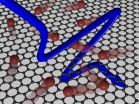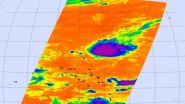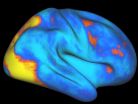(Press-News.org) Scientists, including SFU professor Peter Ruben, have found that sudden death caused by cardiac arrhythmia can be triggered by changes in body temperature. The study is published in the Journal of Physiology.
The soccer player who drops dead in the middle of a game, or the infant who dies during sleep is often a victim of arrhythmia. Sudden cardiac death has several causes, including inheritable mutations in our DNA affecting structure and function of proteins in the heart. Simon Fraser University professor Peter Ruben found when studying the proteins that underlie electrical signaling in the heart, and subjecting those proteins to conditions that are similar to the stress of exercise, in some cases, temperature can cause changes that trigger arrhythmia.
According to Ruben, a professor in the Department of Biomedical Physiology and Kinesiology (BPK), when muscle cells in our hearts contract rhythmically and in a well-coordinated way, the heart efficiently pumps blood throughout our bodies. When the rhythmic pumping action is disrupted by an arrhythmia, our hearts can no longer distribute blood.
In extreme cases, this leads to sudden cardiac death. He adds: "The electrical signal behind muscle contraction is produced by tiny protein molecules in the membrane of our heart cells. Temperature fluctuations modify the way all proteins behave, but some DNA mutations can make proteins especially sensitive to changes in temperature."
Ruben's team found a protein that is far more sensitive to temperature than normal. When normal body temperature goes up for example, during exercise, or goes down during sleep, the affected protein no longer functions normally. The disrupted protein function causes the electrical signal in our heart to become erratic, triggering an arrhythmia and, potentially, sudden cardiac death.
The DNA mutation that creates more temperature-sensitive proteins is very rare, but it can produce deadly results when combined with another arrhythmia trigger, such as changes in the acid content of our blood that occur normally as a by-product of exercise and sleep, particularly sleep apnea.
"For many years, we have studied sodium channels, the proteins in our hearts that produce electrical signals. An earlier study of ours found that temperature changes are a trigger for some seizure disorders. We imagined that cardiac arrhythmias are like seizures and wondered whether they might share the same triggers."
Ruben notes that with this new knowledge, people can examine their family histories and, if sudden cardiac death is part of that family history, or if they suffer from unexplained fainting, they can seek medical advice. Through a combination of electrocardiograms, genetic screening, and lifestyle management, some tragic deaths caused by cardiac arrhythmia may be prevented.
INFORMATION:
ABOUT SIMON FRASER UNIVERSITY:
As Canada's engaged university, SFU is defined by its dynamic integration of innovative education, cutting-edge research and far-reaching community engagement. SFU was founded almost 50 years ago with a mission to be a different kind of university--to bring an interdisciplinary approach to learning, embrace bold initiatives, and engage with communities near and far. Today, SFU is a leader amongst Canada's comprehensive research universities and is ranked one of the top universities in the world under 50 years of age. With campuses in British Columbia's three largest cities--Vancouver, Surrey and Burnaby--SFU has eight faculties, delivers almost 150 programs to over 30,000 students, and boasts more than 130,000 alumni in 130 countries around the world.
Simon Fraser University
University Communications
778.782.3210 http://www.sfu.ca/university-communications
Contact:
Peter Ruben, Department of Biomedical Physiology and Kinesiology 778.782-9351, pruben@sfu.ca
Diane Mar-Nicolle, Faculty of Science, Communications 778.782-9586,
dianem@sfu.ca
Photo: http://at.sfu.ca/magXfG
A recent study looks at why some children put on weight faster than others. The study's goal is to identify factors that can lead to obesity.
Assistant Professor Silje Steinsbekk and Professor Lars Wichstrøm at the Norwegian University of Science and Technology's Department of Psychology are conducting the survey. "We've looked to see if physical activity, television time and appetite traits can explain why some children's body mass index (BMI) increases more than others' do," says Steinsbekk.
At the clinic, most parents have seen the percentile curves on the ...
PHOENIX, Ariz. -- July 15, 2015 -- Researchers at the Translational Genomics Research Institute (TGen) have identified a genetic mutation associated with the appearance of premature aging and severe loss of body fat in children.
TGen's Center for Rare Childhood Disorders found that the appearance of premature aging, a neonatal form of Progeroid syndrome, in a 3-year-old girl was caused by a mutation in the gene CAV1, according to a study published today in the scientific journal PLOS ONE.
The Center for Rare Childhood Disorders was established in 2010 to examine the ...
15 July, 2015, Hoffman Estates, IL - Sodium intake in the U.S. exceeds dietary recommendations and has been identified as a nutrient of public health concern in the Scientific Report of the 2015 Dietary Guidelines Advisory Committee1 due to its link to increased risk of hypertension, heart disease, and stroke2. While authorities continue to call for people to lower their sodium intake, much progress still needs to be made and multiple solutions are necessary to meet the recommended maximum intake of 2,300 milligrams per day for the general population and 1,500 milligrams ...
Mainz/Barcelona. A team of scientists at the Max Planck Institute for Polymer Research (MPI-P) discovered that electrical conduction in graphene on the picosecond timescale - a picosecond being one thousandth of one billionth of a second - is governed by the same basic laws that describe the thermal properties of gases. This much simpler thermodynamic approach to the electrical conduction in graphene will allow scientists and engineers not only to better understand but also to improve the performance of graphene-based nanoelectronic devices.
The researchers found that ...
Researchers at Harvard University and the University of California, San Diego, have developed a new user-friendly resource to accompany the powerful gene editing tool called CRISPR/Cas9, which has been widely adopted to make precise, targeted changes in DNA. This breakthrough has the potential to facilitate new discoveries in gene therapies and basic genetics research. The research was published in the July 13 issue of Nature Methods.
The study describes an approach to simplify a laborious part of the gene editing process using the CRISPR/Cas9 system: choosing the best ...
Sudden unexpected death in epilepsy (SUDEP) is becoming increasingly recognized as a very real and devastating problem in which impaired breathing is thought to play a critical role. Researchers believe breathing may be impaired during and after seizures, without the patient's knowledge.
By using electrical stimulation to activate the amygdala, a group of University of Iowa researchers has identified areas of the human brain in which breathing is controlled and, in some cases, impaired, providing an important insight into SUDEP.
Their study - which marks the first time ...
NASA's Aqua satellite flew over Typhoon Halola in the northwestern Pacific Ocean and captured temperature data on the storm. Satellite data showed that wind shear is affecting the stubborn storm.
NASA's Aqua satellite passed over Halola on July 14 at 20:20 UTC (4:20 p.m. EDT/1:20 p.m. PDT) infrared data from the Atmospheric Infrared Sounder or AIRS instrument that also flies aboard Aqua showed cloud top temperatures were as cold as -63F/-52C. Cloud top temperatures that cold have the ability to drop heavy rainfall.
The Joint Typhoon Warning Center noted that animated ...
High school students who take part in pre-college programs that focus on science are much more likely to pursue higher education and, eventually, careers in science, technology, engineering and medicine - the STEM disciplines.
In a paper published in the Journal of Higher Education Outreach and Engagement, Michigan State University researchers from the National Superconducting Cyclotron Laboratory, the Joint Institute for Nuclear Astrophysics and the College of Education used an MSU program as a case study for why these programs are key to training tomorrow's generation ...
PHILADELPHIA, PA - July 15, 2015 - Obstructive Sleep Apnea (OSA) remains under-recognized in hospitalized patients, despite being associated with cardiovascular complications and sudden death. A multi-disciplinary group of researchers and physicians at Thomas Jefferson University and Hospitals have created a clinical pathway, or screening process, to identify the disorder in higher-risk, hospitalized patients and recently published the results in the Journal of Clinical Sleep Medicine.
"The results showed that our screening process identified sleep disordered breathing ...
New York, NY, July 15, 2015--Researchers at Columbia University Medical Center (CUMC) have found that key parts of the human brain network that give us the power to control and redirect our attention--a core cognitive ability--may be unique to humans. The research, which was published in the July 13 online edition of the Proceedings of the National Academy of Sciences, suggests that the network may have evolved in response to increasingly complex social cues.
"The human brain is powerful, but even it cannot make sense of the entire sum of stimuli that bombard our senses," ...



